| |
|
LETTER FROM JERUSALEM
Do Jews have a gene for excess conscience?
By Ira Sharkansky
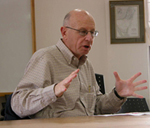 JERUSALEM—We heard the other day an interview with a university researcher who claimed to have located a part of the gene code that makes people more or less likely to be generous. He was careful to say that genetics do not determine how one will behave. There is room for education and experience to influence how one reacts to a plea for help. JERUSALEM—We heard the other day an interview with a university researcher who claimed to have located a part of the gene code that makes people more or less likely to be generous. He was careful to say that genetics do not determine how one will behave. There is room for education and experience to influence how one reacts to a plea for help.
When the research team finishes with generosity, I suggest that it
Ira Sharkansky
investigate the genetic source of conscience. My suspicion is that Jews have a greater amount than other people.
How else to explain the honored place given to the biblical prophets who were shrill critics of the elites. I know of no other ritual that devotes the equivalent of the Haftorah to the likes of Amos, Hosea, Jeremiah, and Isaiah. Nothing was good enough for them. They wanted justice, defined in the most demanding of ways, with no compromise for those who were rich, occupied the highest offices, or who could sing the formal rituals of the Temple.
We have our modern equivalents. Those who attract my attention spare no adjectives to condemn sins against Arabs, while overlooking the mayhem that Arabs cause Israelis.
Ha'aretz is as good a place as any to find contemporary writing that can supply new Haftorah readings to update the tradition.
A recent example is an op-ed piece which celebrates the fact that leading Israelis cannot set foot in a number of Western European countries out of fear of being arrested as war criminals. Their crimes are having been associated with military attacks on leading figures in the war against Israel. Those Israeli attacks also caused the collateral damage of civilian deaths and injuries. It is a shame, according to the commentator, that the Israelis are not being tried for war crimes in Israeli courts.
A difference between this and the books of the Bible is that the ancient prophets were concerned with the moral and physical security of the Jewish people. In the op-ed piece at issue, I find no concern for the Israelis deaths that brought about the IDF's attack.
Yet another candidate for the new Haftorah is an article headlined, "Racism reaching new heights in Israel, civil rights group says" It summarizes the annual report of the Association for Civil Rights in Israel, issued to coincide with Human Rights Week.
Among its findings are a rise in anti-Arab incidents, and public opinion surveys that find substantial numbers of Israelis who have negative opinions about Arabs, do not want Arabs living near them, would not invite an Arab to their homes, do not believe that Arabs should have equal rights, and are inclined to promote the emigration of Arabs from Israel.
The full report of the Association for Civil Rights in Israel, available only in Hebrew, documents numerous other faults. It begins with a segment on the rights of Israelis to obtain medical treatment. This sets the tone of hyperbolic accusations that do not pause for detail. The claim that hospital facilities are the worst of Western countries, and that poor Israelis and especially Israeli Arabs lack equal medical opportunities is out of step with the universal coverage of Health Maintenance Organizations, as well as waiting times to see specialists or arrange operations substantially less than the norms in Great Britain or Canada. Americans stuck with no insurance, or stingy coverage, sizable deductibles and co-pays, would welcome the opportunity to become poor Israelis or Israeli Arabs.
The Biblical prophets may have been right. The kings and other elites of the Jews may have been as self-serving as other elites in ancient and not-so-ancient times. Modern Israel is no Paradise on Earth. There is meanness, exploitation, and inequality. Few of us love our neighbors as ourselves.
No less extreme than these faults, however, is that we are outspoken in criticism of ourselves. Perhaps there is a gene involved in our conscience that inclines us to be unlike others.
If it is a matter of genes, it appears that our Arab neighbors have an opposite kind of DNA. There is no evidence of a conscience gene in what they write and say. Quite the contrary. They claim a monopoly of having suffered at the hands of others. Guess who is responsible? If a researcher dares conclude that some or many of the "Palestinians" came from elsewhere, that is a frontal assault on their narrative. By their story, all of them have been here forever. The Jews are the interlopers, with a doubtful story of being here in the distant past. Should they be pressed for details, they can cite Muslim tradition that it was Ishmael who Abraham went to sacrifice, and the event took place near Mecca. Israel as a Jewish state? Impossible. That violates the rights of Arabs. The claims of Jews who left Arab countries under pressure? They left of their own volition. The Arabs who left Israel during the War of Independence? All of them were hounded out or worse. Arab attacks on Jews and the missiles fired toward Sderot? The inalienable rights of resisting Jewish conquest. Israel's development? The rape of Arab land. The military responses of the IDF? Violations of Arab human rights.
Is it any wonder that not all of us love our neighbors? Perhaps the gene of conscience, which we may have in excess, has not worked its power against Jewish experience.
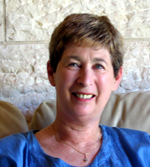 MEVASSERET ZION, ISRAEL—And the rains came. Since water in Israel is a very precious commodity, whenever the first winter rains descend the nation rejoices. After that first moment of elation, however, we start longing for the sun to reappear. Israelis are used to seeing that golden orb beaming down on them for most of their waking hours, and many people get quite downcast when it is obscured by clouds for more than a day or two. MEVASSERET ZION, ISRAEL—And the rains came. Since water in Israel is a very precious commodity, whenever the first winter rains descend the nation rejoices. After that first moment of elation, however, we start longing for the sun to reappear. Israelis are used to seeing that golden orb beaming down on them for most of their waking hours, and many people get quite downcast when it is obscured by clouds for more than a day or two.
Of course, there is always the consolation of knowing that in the summer there will be unabated sunshine for months on end, and then one will be able
Dorothea Shefer-Vanson
to complain about the interminable heat. But just now, as the depths of winter loom, that is still a very distant prospect.
The Israeli winter is not unalloyed gloom, however. Far from it. There are many days of warm but not hot sunshine, when the air is crisp and cool and the whole world seems to have been burnished after the rain. Those are the days when children refuse to wear their sweaters or forget their coats in school. Those are also the days when I agonise about which shoes to wear, and usually end up wearing the wrong ones.
These are also the days when everyone is busy coughing and sneezing, except for those who have been laid low with the flu. Some people blame the constant changes in temperature, others the fact that they were not warmly enough dressed (or were too warmly dressed), while true misanthropists tend to blame other people for spreading their germs around.
Everyone has their pet remedy or prophylactic, be it Vitamin C, Achinacea, liquorice or chicken soup. But when all is said and done, just like the winter, the common cold has to be allowed to take its course. All one can do is hope to emerge from both stronger and more resilient.


THE GREENE LINE
Tel Aviv unblocked this San Diego writer
By Norman Greene
SAN DIEGO—I’ve read about it and seen it depicted in movies, but have never experienced it...until now. I’m talking about “writer’s block,” a condition I have experienced in the last several months.
So, I thought a change of scene would be inspirational and off we flew to France. According to our editor, Don Harrison, “there is a Jewish story everywhere.” All I had to do was find a few and presto!, my writer’s block would dissolve.
France, with the second largest concentration of Jews in Europe, should have been the place, but there is nothing Jewish about six days of rain in Paris and I had previously written about visits to the Jewish Museum. There was nothing particularly Jewish about the fall of the dollar and the companion increase of the Euro making everything exorbitantly expensive for the dwindling numbers of American tourists.
The large increase in the numbers of French Jews visiting and relocating to Israel has been well reported by others. A two-week tourist, even with French relatives, has little additional insight to add to this story.
Of course, my 80 year old cousin Gisele’s birthday party in Versailles was a high point of our visit, but hardly grist for a writer. Gisele and her late mother, Anna, lived through the Holocaust in Paris, but surprisingly have very few stories to share about that ugly period of time. Basically, they just survived the Nazi occupation and life went on after the war. One of Anna’s uncles, Bernard, was lost in a German concentration camp. The rest seems to have been a blank page.
As far as the birthday celebration was concerned, the Trianon Palace Hotel, snuggled up against the palace grounds, was an elegant setting, but again offered nothing with a Jewish root unless ownership of Weston Hotel stock qualifies. It almost goes without saying that the hotel charges were astronomic.
So it was with great pleasure, from a writer’s point of view, that we left France for Israel. Surely, there was new material on which to comment there.
Our hosts in Tel Aviv were Admiral (rt.) Abraham Ben Shoshan, executive director of The Tel Aviv Foundation, and Meggie Navon, U.S. operating manager for the Foundation, as well as Mayor Ron Huldai. We were met at Ben Gurion Airport and squired off to the bustling David Intercontinental Hotel on the shores of the Mediterranean.
Tel Aviv is in a dynamic growth phase with cranes and new construction in abundance everywhere. The city pulses with activity and a sense of well-being that I never experienced in Israel before. The Foundation, in lock step with the Mayor, is changing the face of Tel Aviv. Everywhere there are new parks and newly planted greenery giving the city a welcoming appeal to families. The transformation is similar to what is happening to downtown San Diego.
Most importantly, a new emphasis has been placed on education. The Foundation, matched dollar for dollar by the City, has been heavily investing in building and refurbishing kindergartens, pre-school resource centers, high schools and a new T A College campus...all of which we toured...including the (Jaime) Brener, (Gert) Thaler and (Harvey&Linda) Neiman Family Kindergarten and a college building named after Ruben Rosental’s father. A new library center at the college will be dedicated to the memory of Vivian Ressler’s father in the coming months. All of these people are San Diegans.
My wife was impressed by the fact that Tel Aviv is accepting refugees from Darfur and immediately enrolling their children in the public schools. This is not the case with many other Israeli cities. While we were visiting, Bialiak Rogovin High school and its dynamic principal Karen Tal, four students showed up seeking admittance. The argument could be made that these children are not Jewish and, therefore, should not be supported by City funds. However, Mayor Huldai argues that children are children and all need to be educated. “This is the Jewish way,” he says.
I was impressed by the fact that .97 of the dollar donated to the Tel Aviv Foundation goes directly to the designated project and is always matched by City funds. The Foundation, unlike many international Jewish organizations, has a low overhead of only 3 percent.
It wasn’t long before my wife, who had genuinely feared a trip to Israel, loosened up and enjoyed the fabulous restaurants along the Mediterranean and in the City, the late night skyline views from atop the David Intercontinental, the strolls along the New Yarkon River Park, the art collections in the TA Museum, the quick shopping excursions, the unique modern architecture and the general vibrancy of Tel Aviv.
For the first time in some eleven trips to Israel, I was more excited to be in Tel Aviv than in Jerusalem. And by the way, I am back to my computer writing once more.
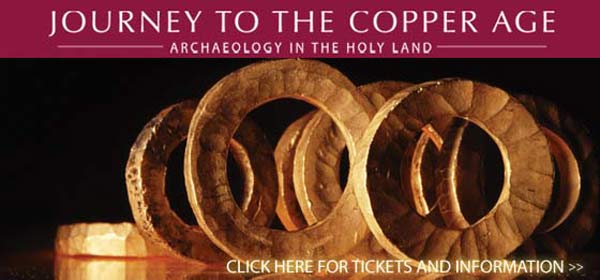

|
A wonderfully cohesive program brilliantly executed ... Zina Schiff is a first rate violinist fully up to the music's tremendous technical challenges ... who can get inside the soul of Bloch's extravagantly expressive music |
|
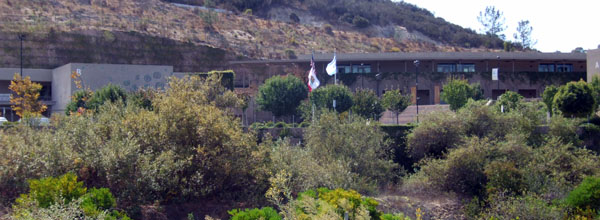
THE JEWISH CITIZEN
Exhibit to preview possible creation of a School of the Arts within SDJA next year
By Donald H. Harrison
 SAN DIEGO—Many people have heard of retrospective art exhibits, but San Diego Jewish Academy will mount a prospective exhibit on Tuesday evening, December 18 at its Maimonides Upper School. The show is one that organizers hope will help change the way some artistically-motivated students are educated on the campus—perhaps as early as the next school year. SAN DIEGO—Many people have heard of retrospective art exhibits, but San Diego Jewish Academy will mount a prospective exhibit on Tuesday evening, December 18 at its Maimonides Upper School. The show is one that organizers hope will help change the way some artistically-motivated students are educated on the campus—perhaps as early as the next school year.
Since the beginning of the current term, teachers in various fields of the
Donald H. Harrison
arts—led by Doug Kipperman, who teaches graphic and visual arts—have been working together in what they call the "Arts Collective," a confederation of faculty engaged not only in teaching visual-image creation, ceramics and photography but also in music and drama.
Kipperman, Humanities Department chair Melissa McKinstry, and SDJA Principal Jeff Davis all came to San Diego Jewish Academy from Coronado High School, where a 'School of the Arts' is operated as a program within the high school. The three are interested in adapting the Coronado model and fashioning a "school within a school" for SDJA.
"I would like to see a school develop where serious students in the arts get an opportunity to have a well-articulalated pre-professional program that will allow them to earn scholarships to go to arts schools of their choices, or to work as professionals in the arts," said Kipperman, who along with his colleagues on the faculty, is developing a proposal for the school to submit to Davis.
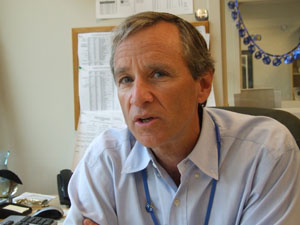 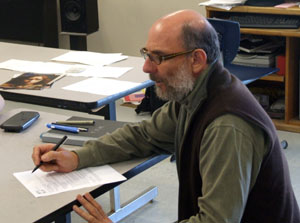
Photos by Donald H. Harrison and William Bohannon
While endorsing the concept in principle, the principal said there are various issues to be worked out. SDJA students already attend eight classes compared to the typical six in public school in order to have time to learn both secular and Jewish subjects. The trick for Kipperman and his colleagues, said Davis, will be to come up with a proposal that somehow marries an arts curriculum to the mixed secular and Judaic curricula already in place.
This may not be as hard as it sounds, suggests Davis, assuming that various classes can be taught through the medium of an art, or perhaps even by combining arts programs. Do students need to learn about Jewish holidays? Perhaps they can do so by learning those holiday's histories, legends, and customs and then create drawings or documentaries or plays about them.
Davis said the Coronado program began about ten years ago, while he was principal at the high school there. "Realizing that we were not addressing the needs of a group of kids, we had a goal at Coronado High School to have the school fit the student and not the other way around. We realized that everybody doesn't fit into round holes, and that we were trying to force some squares into round holes."
Although the school had special programs for kids who were computer whizzes, and those who were into such vocational subjects as automobiles and mechanical disciplines, "we realized that the kids who were somewhat disenfranchised were the artistic kids," some of whom were not doing well in traditional academic classes.
"So," said Davis, "not only did we look at providing ways to augment their artistic talents in a really expanded program, but also developed away to address the traditional secular academic program for them." For such students, Coronado High School offers the option of working in academic subjects independently at their own pace from 8 a.m. to noon, and to also take an intense series of arts courses from 12 to 5 p.m.
Tuesday evening at SDJA will not be simply a chance for people to look at isolated examples of students' art works; it is intended to demonstrate how the various arts disciplines intermesh in a way that can spark the imaginations of the kinds of students whom Kipperman describes as people who "think outside the box."
Kipperman said he hopes that the exhibit will ignite the interest of parents and visitors, prompting them to investigate and to support the school-within-a-school concept. He said attendees will enter one room in the "E" Building of SDJA's Maimonides Upper School and "be able to watch student-produced videos, look at art, and then see a performance by the Academy on Stage performance troupe. Then they will go into the next room and listen to some music, and finally return to the main room, where they will be able to view different pieces on exhibit in the gallery."
The theme of the exhibit is "Connections," exploring the ways which different art forms can influence or be linked to each other. Further information may be obtained from the San Diego Jewish Academy at 11860 Carmel Creek Rd., in the Carmel Valley area of San Diego, by calling (858) 704-3700, or by visiting the school's website.

SAN DIEGO JEWISH WORLD THE WEEK IN REVIEW
TUESDAY, DECEMBER 11
Donald H. Harrison in San Diego: Former 'Little' Pal now a mentor himself.
Larry Zeiger in La Jolla, California: Cry Baby: A flashback to the 1950's.
MONDAY, DECEMBER 10
Donald H. Harrison in San Diego: Synagogue bids farewell to a woman who shunned the honors that inundated her
Sheila Orysiek in San Diego: City Ballet's Nutcracker sparkles
SUNDAY, DECEMBER 9
Alanna Berman in San Diego: Conference probes 'duty' of Jewish journalists toward Israel's image
Shoshana Bryen in Washington D.C.: Capability more important than 'intent' in measuring nuclear danger from Iran
Donald H. Harrison in San Diego: San Diego connections fail to rescue Shadow Soldier from fear of intimacy
Rabbi Baruch Lederman in San Diego: When all seems impossible, then persevere
Rabbi Leonard Rosenthal in San Diego: Wicked examines quesiton of 'otherness'
FRIDAY, DECEMBER 7-SATURDAY, DECEMBER 8
Shoshana Bryen in Washington D.C.: Questions abound about NIE assessment
Donald H. Harrison in San Diego: Let's stop demonizing undocumented immigrants; let's help Mexico's economy
Sheila Orysiek in San Diego: If U.S. intelligence was so wrong about Iraq, why does Left believe it about Iran? Reader Response
Michael M. Rosen in San Diego: Boling takes San Diego City Council campaign to Beth Jacob Congregation
THURSDAY, DECEMBER 6
Shoshana Bryen in Washington D.C.: NIE has 'moderate confidence' Iran has not reactivated its nuclear weapons program
Peter Garas in Canberra, Australia: Stingy? Friendly to strangers? You may be genetically predisposed to such behaviors
Irv Hackel in Brookyn, N.Y.: 'There are angels out there' at Ezer Mizion
Donald H. Harrison in San Diego: His remains sent from Poland to U.S. so he could be buried where Jews would visit
Donald H. Harrison: Chanukah at Hillel: A meshuganah auction
Ira Sharkansky in Jerusalem: Shock and disbelief in Israel over U.S. latest estimate on Iran's nuclear program
< BACK TO TOP
|
|

